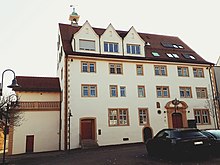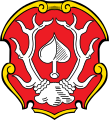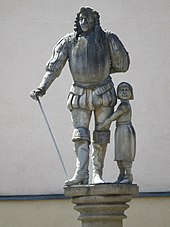Kaltental (noble family)

The lords of Kaltental (also: Kaltenthal ) were a Swabian noble family who had their possessions in the Middle Ages and early modern times in what is now the Stuttgart region and in the Allgäu .
history
Origin and headquarters
The family's name-giving ancestral seat was the abandoned Kaltental Castle in what is now Stuttgart's southern district . The castle was probably built by the local nobility to protect the Nesenbach valley . The Lords of Kaltental were first mentioned in a document in 1125 in a document from the Hirsau monastery . Originally they were Guelph and later the Tübingen and, from 1308, Württemberg ministerials . In the 13th century they were temporarily owned by a burgrave office, which probably also included Stuttgart. In 1318 the brothers Johann, Rudolf and Walter von Kaltental sold their ancestral castle to Count Eberhardt the illustrious and moved their residence to Aldingen in what is now the town of Remseck am Neckar . Around 1488 the Lords of Kaltenthal were members of the society with St. Jörgenschild . Since 1542 they were registered in the Swabian knight canton of Kocher and thus part of the imperial knighthood . At the turn of the 17th to the 18th century, they were also members of the Franconian canton of Odenwald . The family went out towards the end of the 19th century or the beginning of the 20th century.
Other possessions
The long-term possessions of the Lords of Kaltental are described below. In addition, there were other temporary possessions, such as Rabeneck Castle or the Neuhausen rule , as well as numerous isolated estates and farms, especially in today's Stuttgart region. However, they did not manage to keep their family property, some of which were widely scattered, in one hand.
Aldingen
In 1278 Burgrave Walter von Kaltental and his sons Johann and Gozzo received the local rule in Aldingen as a fief from Count Ulrich von Tübingen-Asperg . In the course of the 14th century, the family expanded their Aldinger property by purchasing their own property . Around this time the construction of the first, no longer preserved, Kaltental nobility seat in Aldingen also took place. Together with the local Margaret Church, it formed a castle complex .
In the course of the Reformation , the Aldinger part of the family split into a Catholic and a more important Protestant line. The evangelical line in Aldingen went back to the brothers Reinhardt and Heinrich von Kaltental. The two brothers, unlike their cousin Philipp, converted to the Protestant denomination in 1568 after increasing pressure from Württemberg . It was also Heinrich von Kaltental who had Aldingen Castle built as the seat of the Protestant line. The Catholic line founded by Phillipp von Kaltental remained in the original seat at the Margaretenkirche. This line died out in the 17th century.
Aldingen remained Kaltental until 1746. Georg Wolf von Kaltental, the last member of the Aldinger line, died that year, whereupon Württemberg took control. However, since it was partly owned by the von Kaltental family, the remaining relatives complained. In 1750, three cousins of Georg Wolf finally received financial compensation and goods in Köngen , which Württemberg bought back from the Kaltentalers in 1779.
Twenty-four of the original thirty-six grave monuments belonging to the von Kaltental family have been preserved in the Margaret Church in Aldingen. Furthermore, two paintings as epitaphs for Heinrich von Kaltental and Agatha von Kaltental.
Oßweil
Since the middle of the 15th century, the Lords of Kaltental appeared next to the Counts of Württemberg and other parties as the successors of the Lords of Oßweil as local lords. Today Oßweil is a district of the city of Ludwigsburg . The family seat in Oßweiler was originally Schloss Oßweil , which was sold to Messrs. Nothaft von Hohenberg in 1621 . In 1751 Württemberg bought the remaining goods in Oßweil from the Lords of Kaltental, after the rest of the town had already come into Württemberg possession.
Mulhouse
In 1461 Caspar and Heinrich von Kaltenthal bought parts of the local rule over Mühlhausen , which is now a district and district of the city of Stuttgart . Around 1500, Jakob von Kaltental completed the property.
Engelbold von Kaltental introduced the Reformation in Mühlhausen in 1556. The Engelburg ruins are presumably named after him . After Engelbold died in 1582, his two daughters divided the inheritance. Individual farms remained as a Württemberg fiefdom with the Osterzeller and Aldinger branches of the family. Georg Christian von Kaltental zu Osterzell sold his share in 1691. One last farm remained with the Kaltental zu Aldingen. With the rest of the Aldinger possessions it went to Württemberg in 1746.
The St. Vitus Chapel served as a burial place for this branch of the family .
Osterzell
In 1535 the royal councilor Jakob von Kaltental, who was wealthy in Mühlhausen and Oßweil, bought the villages of Osterzell with the hamlet of Oberzell , Ödwang with the hamlet of Tremmelschwang , Hirschzell and the desert areas of Stocken , Salabeuren , Empisried and Hergertshofen for around 20150 guilders. From this he formed the rule Osterzell. In the construction of Osterzell Castle , the remains of an older building were included, which Burkhard II von Kaltental had built in the 16th century. The burial place of the Osterzeller line was the parish church of St. Stephan and Oswald, here, for example, there is a statue of Burkhardt II. In 1699 Georg Christoph von Kaltental , known as the wild Junker Jörg , sold the rule to the Rottenbuch monastery .
The naming of the market town of Kaltental , which was established near Osterzell in 1971, has no real historical reference to the Kaltental family. The three predecessor municipalities were in the cold valley , i.e. the area in which the Kaltental rule was once located. In the meantime, both Osterzell, which was once Kaltental, and the market town of Kaltental belong to the administrative community of Westendorf .
coat of arms
The coat of arms of the Lords of Kaltental shows in red a silver deer antler with grind. On the helmet with red and silver covers a growing (red and silver) deer head, the exact representation of which differs in detail in various heraldic books . Individual depictions, such as the oath shield of Philipp Achilles Baron von Kaltenthal in the Order Church of St. Georgen , show a golden deer antler in the coat of arms instead of a silver one and a red and gold cover.
The former municipality of Kaltental used the Kaltental coat of arms until it was incorporated into Stuttgart in 1922. For the coat of arms of the Osterzell community, the Kaltental's deer antlers were combined with the beech leaf of the Rottenbuch monastery.
Georg Friedrich von Kaltental and the orphan Adiz
In 1997 the sculptor Peter Lenk created the concrete sculpture Georg Friedrich von Kaltental and the orphan Adiz, also called Der Kaltentaler for short . It is set up in Remseck-Aldingen in front of the passage to the courtyard of Aldingen Castle.
The Kaltentaler Georg Friedrich depicted in the sculpture was born in Aldingen in 1649. He joined the Württemberg army, in whose service he took part in the siege of Belgrade in 1688 as Rittmeister . From there he brought the 15-year-old Turkish orphan Adiz with him to his homeland. Lenk's sculpture, however, shows Adiz as a much younger child. Adiz was raised in Aldingen by Georg Friedrich's childless brother and his wife and baptized Christiana Magdalena Sybilla in 1691. In 1694 Christiana and Hans married Jerg Menner, a forester and from 1724 mayor of Affalterbach and Wolfsölden. According to some sources, the marriage remained childless, others speak of five children whom Christiana gave birth to before she died in 1739. Georg Friedrich himself died in 1697 shortly before the Peace of Rijswijk in the Palatinate War of Succession as colonel of a Württemberg dragoon regiment in battle near Bühl .
See also: Prey Turks
"Cold Thaler" gift voucher
The motif of Lenk's sculpture was also used by retailers in cooperation with the city of Remseck as a representation on a gift voucher in the form of a commemorative coin. This coin, known as the “Cold Thaler”, could be purchased from December 2009 for € 5 and redeemed in the shops involved.
Known family members
- Walter von Kaltental; Commander of the Teutonic Order in Kapfenburg (around 1384); Land commander of the Ballei Lorraine (around 1383)
- Jakob von Kaltental (1479–1555), court judge and royal councilor, founder of the Osterzell rule
- Heinrich von Kaltental (1534–1608), builder of Aldingen Castle, introduced the Reformation in Aldingen together with his brother Reinhardt
- Dr. Kaspar von Kaltenthal († 1552), judge and cathedral chapter of Augsburg, was involved in the Regensburg Religious Discussion in 1546
- Philipp Jakob von Kaltenthal (around 1627–1669), Commander of the Teutonic Order and builder of the Maria Birnbaum pilgrimage church in Sielenbach in Ostallgäu
- Georg Friedrich von Kaltental (1649–1697), Württemberg officer, in his honor in Aldingen the statue Georg Friedrich von Kaltental and the orphan Adiz (concrete sculpture by Peter Lenk )
- Georg Wolf von Kaltental (1681–1746), son of Georg Friedrich von Kaltental, director of the knight's canton Kocher (since 1731), Obervogt zu Kirchheim , Nürtingen , Denkendorf , Wendlingen , Neidlingen and Owen (since 1733), last Kaltental lord of Aldingen
- Margarete Ernestine von Kaltenthal, mother of Karl Freiherr von Drais
- Church buildings associated with the Lords of Kaltental
See also
Web link
Individual evidence
- ↑ a b c d e f g h Dr. Norbert Stein, Eduard Theiner, Heinz Pfizenmayer: The Lords of Kaltental and the imperial free Nothaft von Hohenberg . In: Heinz Pfizenmayer (Hrsg.): Local history series of publications of the municipality of Remseck am Neckar . tape 9 , 1989.
- ^ Gerhard Köbler: The German territories from the Middle Ages to the present . 7th edition. CH Beck, Munich 2007, ISBN 978-3-406-54986-1 , p. 325 .
- ^ Bernhard Peter: Photos of beautiful old coats of arms No. 2584 Bayreuth (Upper Franconia). In: Heraldry - the world of coats of arms. Accessed May 31, 2020 .
- ^ August Friedrich Pauly: Description of the Oberamt Eßlingen. Chapter B 9 - Neuhausen. 1845, accessed May 31, 2020 .
- ^ Eduard Paulus: Description of the Oberamt Stuttgart, Office. Chapter B 14 - Möhringen. 1851 .
- ^ Karl Eduard Paulus: Description of the Oberamt Ludwigsburg. Chapter B2 - Aldingen. Royal Statistical-Topographical Bureau Württemberg, 1859 .
- ↑ a b Dr. Jochen Tolk: The Margaret Church in Aldingen . In: Eduard Theiner (Hrsg.): Local history series of publications of the community of Remseck am Neckar . tape 15 , 1996.
- ^ A b Karl Eduard Paulus: Description of the Oberamt Ludwigsburg. Chapter B16 - Oßweil. Royal Statistical-Topographical Bureau Württemberg, 1859 .
- ↑ Harald Stark: Review of the Notthracht-Exkusion 2002. In: notthracht.de. Retrieved May 28, 2020 .
- ↑ Johann Daniel Georg von Memminger: Description of the upper office Canstatt. Chapter B 5 - Mühlhausen. Royal Statistical-Topographical Bureau Württemberg, 1832 .
- ^ Chronicle of the Osterzell community. In: osterzell.de. Osterzell community, accessed on May 28, 2020 .
- ^ Stephanie Heyl: Bavaria's communities - Osterzell community. In: hdbg.eu. House of Bavarian History, accessed on May 28, 2020 .
- ^ Stephanie Heyl: Bavaria's municipalities - market Kaltental. In: hdbg.eu. House of Bavarian History, accessed on May 28, 2020 .
- ^ Rolf-Torsten Heinrich: Erfurt Wappenbuch part 3 . Books on Demand, 2015, ISBN 978-3-7386-5119-5 ( google.de ).
- ↑ Bernhard Peter: Gallery: Photos of beautiful old coats of arms No. 2584 Bayreuth (Upper Franconia) Ordenskirche St. Georgen, part 2: panels 23-42. In: Heraldry - the world of coats of arms. Accessed September 1, 2020 .
- ↑ a b Georg Friedrich von Kaltental and the orphan Adiz. In: Homepage of Peter Lenk. Retrieved May 29, 2020 .
- ↑ Historical tour through Remseck-Aldingen. (PDF, 806 kB) In: stadt-remseck.de. Retrieved March 13, 2020 .
- ^ Kaltental, Georg Friedrich von. In: German biography. Retrieved May 29, 2020 .
- ↑ A different kind of gift voucher: the Kalten-Taler is here! In: stadt-remseck.de. Retrieved July 24, 2020 .
- ↑ Kaltental, Jakob von. In: German biography. Retrieved May 29, 2020 .
- ^ Ernestine Christine Margaret Baroness von Kellenthal. In: genealogyonline. Retrieved May 30, 2020 .










